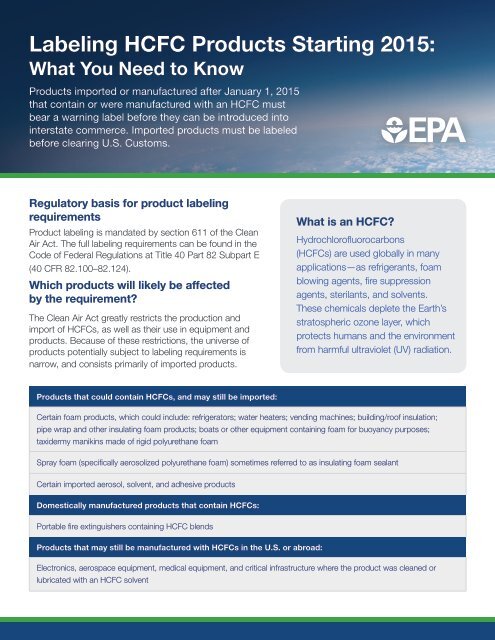Labeling HCFC Products Starting 2015: What You Need to Know
Labeling HCFC Products Starting 2015: What You Need to Know
Labeling HCFC Products Starting 2015: What You Need to Know
You also want an ePaper? Increase the reach of your titles
YUMPU automatically turns print PDFs into web optimized ePapers that Google loves.
<strong>Labeling</strong> <strong>HCFC</strong> <strong>Products</strong> <strong>Starting</strong> <strong>2015</strong>:<br />
<strong>What</strong> <strong>You</strong> <strong>Need</strong> <strong>to</strong> <strong>Know</strong><br />
<strong>Products</strong> imported or manufactured after January 1, <strong>2015</strong><br />
that contain or were manufactured with an <strong>HCFC</strong> must<br />
bear a warning label before they can be introduced in<strong>to</strong><br />
interstate commerce. Imported products must be labeled<br />
before clearing U.S. Cus<strong>to</strong>ms.<br />
Regula<strong>to</strong>ry basis for product labeling<br />
requirements<br />
Product labeling is mandated by section 611 of the Clean<br />
Air Act. The full labeling requirements can be found in the<br />
Code of Federal Regulations at Title 40 Part 82 Subpart E<br />
(40 CFR 82.100–82.124).<br />
Which products will likely be affected<br />
by the requirement?<br />
The Clean Air Act greatly restricts the production and<br />
import of <strong>HCFC</strong>s, as well as their use in equipment and<br />
products. Because of these restrictions, the universe of<br />
products potentially subject <strong>to</strong> labeling requirements is<br />
narrow, and consists primarily of imported products.<br />
<strong>What</strong> is an <strong>HCFC</strong>?<br />
Hydrochlorofluorocarbons<br />
(<strong>HCFC</strong>s) are used globally in many<br />
applications—as refrigerants, foam<br />
blowing agents, fire suppression<br />
agents, sterilants, and solvents.<br />
These chemicals deplete the Earth’s<br />
stra<strong>to</strong>spheric ozone layer, which<br />
protects humans and the environment<br />
from harmful ultraviolet (UV) radiation.<br />
<strong>Products</strong> that could contain <strong>HCFC</strong>s, and may still be imported:<br />
Certain foam products, which could include: refrigera<strong>to</strong>rs; water heaters; vending machines; building/roof insulation;<br />
pipe wrap and other insulating foam products; boats or other equipment containing foam for buoyancy purposes;<br />
taxidermy manikins made of rigid polyurethane foam<br />
Spray foam (specifically aerosolized polyurethane foam) sometimes referred <strong>to</strong> as insulating foam sealant<br />
Certain imported aerosol, solvent, and adhesive products<br />
Domestically manufactured products that contain <strong>HCFC</strong>s:<br />
Portable fire extinguishers containing <strong>HCFC</strong> blends<br />
<strong>Products</strong> that may still be manufactured with <strong>HCFC</strong>s in the U.S. or abroad:<br />
Electronics, aerospace equipment, medical equipment, and critical infrastructure where the product was cleaned or<br />
lubricated with an <strong>HCFC</strong> solvent
<strong>What</strong> must the label say and where should it appear?<br />
The purpose of the label is <strong>to</strong> allow consumers <strong>to</strong> make informed choices before buying products containing<br />
or manufactured with <strong>HCFC</strong>s. To that end, the warning statement must be clearly legible and conspicuous<br />
such that it is likely <strong>to</strong> be read by consumers prior <strong>to</strong> making their purchase. The label must include the<br />
following statement:<br />
WARNING: [Contains / Manufactured with] [name of <strong>HCFC</strong>], a substance that harms public health<br />
and environment by destroying ozone in the upper atmosphere.<br />
The warning may be printed directly on a product or its outer packaging or on an alternative label, including<br />
the following conspicuous placements:<br />
• Principal display panel or display panel area<br />
• Alternative labels, such as hang tags, stickers, or similar overlabeling<br />
• Outer packaging<br />
• Supplemental printed materials, such as invoices, bills of lading, or package inserts<br />
• Promotional materials, such that the warning statement is visible before the time of purchase<br />
Additional information on labeling placement and requirements can be found in the Code of Federal<br />
Regulations at Title 40 Part 82 Subpart E (40 CFR 82.108 and 82.110). The labeling regulations<br />
(40 CFR 82.100–82.124) also contain certain exemptions <strong>to</strong> the requirements, as well as requirements for<br />
when the label must accompany a product that is sold for use in manufacturing another product.<br />
FOR MORE INFORMATION visit http://www.epa.gov/ozone/title6/labeling/index.html, or<br />
contact the ODS Hotline at 1-800-296-1996 or http://www.epa.gov/ozone/comments.htm.<br />
Printed on 100% recycled/recyclable paper with a minimum<br />
50% post-consumer waste using vegetable-based inks.<br />
Office of Air and Radiation (6205J)<br />
EPA-402-E-13-001<br />
August 2013
















